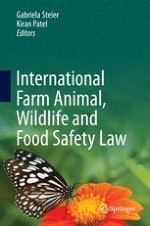Abstract
Population growth, urbanization, changing economies and food preferences have increased pressure on the agricultural sector and on livestock production and related feed crops in particular. The FAO expects an increase of 70 % in world annual agricultural production from 2005/2007 to 2050 to feed the rising population, which is expected to grow by 40 % over the period (Conforti, Looking ahead in world food and agricultural perspectives to 2050, 2011). Much of the increase in crop (cereal) production is expected to come about as a result of increased demand for feed for livestock (Conforti, Looking ahead in world food and agricultural perspectives to 2050, 2011). To keep up with the demand for animal products, the method of production is changing. In the United States and increasingly around the world, family farms raising small numbers of livestock have given way to industrialized livestock practices often referred to as Concentrated Animal Feeding Operations or CAFOs. Livestock facilities confine ever increasing numbers of animals indoors. Vitamin supplements allow livestock to be confined indoors without sunlight and allow the production of offspring year round, while subtherapeutic use of antibiotics allow livestock to be confined in greater numbers and close quarters, raising the number of livestock that could be produced on a given feedlot or facility (Steinfeld, Livestock in a changing landscape: drivers, consequences, and responses, 2010). Genetics management and nutrition have also allowed animal production operations to intensify, and for the productivity of each animal to increase. For example, in the United States in 1957 it took a broiler chicken 101 days and 17.7 pounds of feed to reach market weight, while in 2001 it took only 32 days and only 5.9 pounds of feed. This has allowed US meat production to skyrocket by over 250 % over the past half-century (Pew Commission, Putting meat on the table: industrial farm animal production in America, 2008). Huge amounts of animal waste are a consequence of industrialized livestock. Inadequate regulation of manure deposition and disposal has resulted in significant air, water, and soil pollution. Animal waste from intensified operations is often disposed of on agricultural land year-round, and in far greater amounts than the land can absorb. Soils are over-fertilized thus releasing toxic runoff, and leaching contaminants. The runoff can flow into water bodies causing severe ecological harm, and decomposing waste can release dust particles, bacteria, endotoxins, and volatile organic compounds, as well as hydrogen sulfide, ammonia, and other odorous substances into the air (Halden and Schwab, Environmental impact of industrial farm animal production, 2008). Manure often contains many problematic substances including high levels of nitrogen and phosphorous, endocrine disruptors that can interfere with hormonal signaling in animals and humans, antibiotics that can nurture drug-resistant populations in the soil they are reach, resistant forms of bacteria, and arsenic (Halden and Schwab, Environmental impact of industrial farm animal production, 2008). As noted above, the increase in livestock production increases demand for feed crops thus requiring intensification of agricultural land use and resulting in a host of environmental costs on varying levels including increased erosion, lower soil fertility, reduced biodiversity, pollution of ground water, eutrophication of rivers and lakes, and impacts on atmospheric constituents, climate, and ocean waters (Steinfeld, Livestock’s long shadow: environmental issues and options, 2006). This chapter will address those impacts. It is organized by medium of impact. Section 1.2 addresses air pollution and climate-change related impacts. Section 1.3 provides background on water consumption and pollution related to industrial livestock. Section 1.4 takes on the range of land-based impacts including habitat, forestry and desertification. The text provides an overview of the impacts but offers specific examples from a number of countries. Many of the impacts addressed are covered in more depth and/or with more specificity in later chapters.
